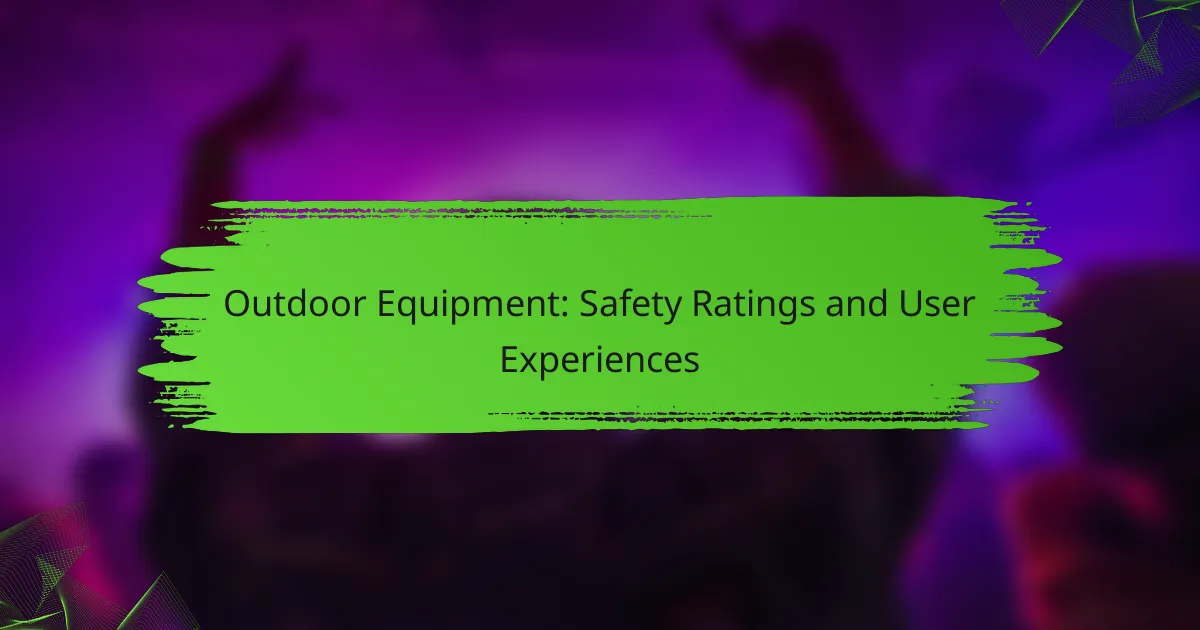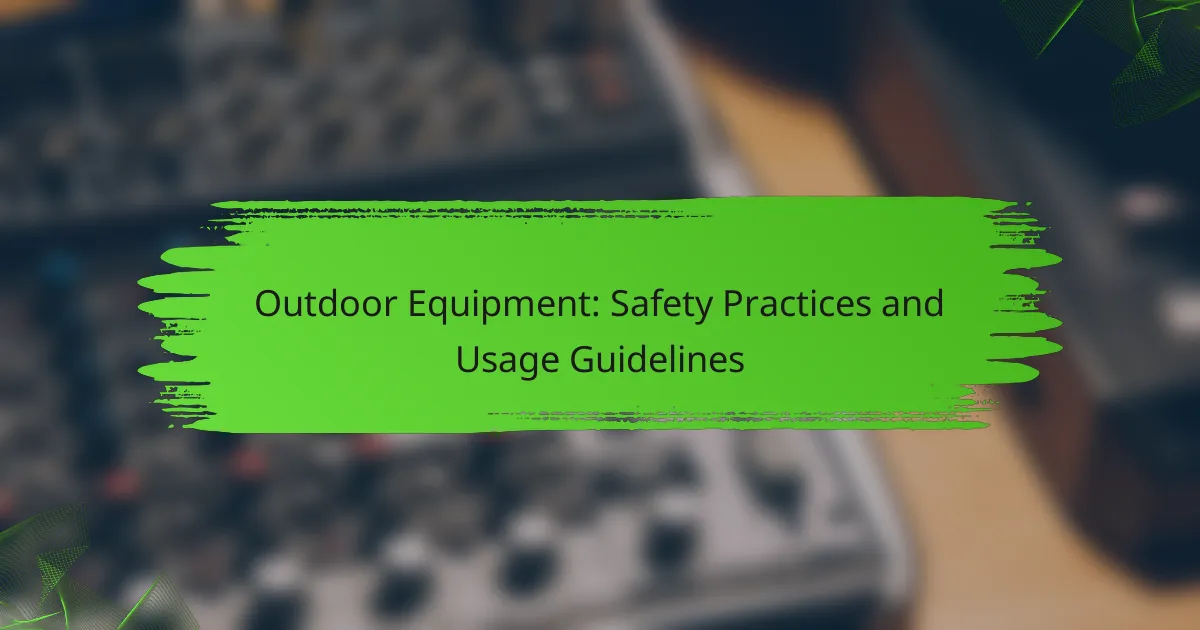When choosing outdoor equipment, understanding safety ratings is essential for ensuring performance and durability. Reputable organizations assess gear based on these criteria, providing consumers with valuable insights. Additionally, user experiences significantly influence perceptions of safety, as feedback can reveal both strengths and potential hazards in products. Brands like North Face, Patagonia, and Columbia are recognized for their commitment to safety and reliability in outdoor gear.

What are the best outdoor equipment safety ratings?
The best outdoor equipment safety ratings come from reputable organizations that evaluate gear based on performance, durability, and user safety. These ratings help consumers make informed choices when selecting equipment for outdoor activities.
Consumer Reports ratings
Consumer Reports provides thorough evaluations of outdoor gear, focusing on safety, reliability, and user satisfaction. Their ratings are based on extensive testing and user feedback, offering a clear picture of how products perform in real-world conditions.
When looking at Consumer Reports, consider the overall score, which combines various factors like safety, ease of use, and durability. A higher score indicates better performance and safety, making it a reliable resource for outdoor enthusiasts.
Outdoor Gear Lab evaluations
Outdoor Gear Lab conducts detailed reviews of outdoor equipment, emphasizing safety and user experience. Their evaluations include hands-on testing in various environments, ensuring that the gear meets practical safety standards.
Look for their comprehensive comparison charts, which highlight key features and safety ratings side by side. This can help you quickly identify the best options for your specific outdoor needs.
REI safety standards
REI sets high safety standards for the products they sell, ensuring that all gear meets rigorous testing criteria. Their in-house experts evaluate equipment for safety, usability, and performance before it reaches consumers.
When shopping at REI, check for their safety certifications and recommendations, which can guide you toward reliable gear that has been vetted for outdoor use.
ASTM certification details
ASTM International develops safety standards for outdoor equipment, covering aspects such as material quality and performance under stress. Products that meet ASTM certification have undergone rigorous testing to ensure they are safe for consumer use.
Look for ASTM certification labels on outdoor gear, as they indicate compliance with established safety benchmarks. This can be particularly important for items like climbing gear, tents, and protective equipment, where safety is paramount.

How do user experiences influence outdoor equipment safety?
User experiences play a crucial role in shaping perceptions of outdoor equipment safety. Feedback from users can highlight potential hazards, reveal product strengths, and influence purchasing decisions, ultimately driving manufacturers to improve safety standards.
User reviews on Amazon
User reviews on Amazon provide valuable insights into the safety and reliability of outdoor equipment. Customers often share their experiences regarding product performance in real-world conditions, which can reveal issues not covered in marketing materials. For instance, a tent that is praised for its waterproof capabilities may receive criticism if users report leaks during heavy rain.
When evaluating reviews, look for patterns in feedback. A product with a high number of positive reviews may indicate reliability, while consistent complaints about safety features should raise red flags. Pay attention to verified purchases for more credible insights.
Feedback from outdoor forums
Outdoor forums are rich sources of user experiences that can provide detailed safety evaluations of equipment. Enthusiasts often discuss specific incidents, such as gear failures during expeditions, which can inform others about potential risks. These discussions can also highlight safety certifications and standards that may not be widely advertised.
Engaging with these communities can help you gather diverse opinions and practical advice. Look for threads that focus on safety concerns and ask questions to gain deeper insights into the equipment’s performance in various environments.
Social media testimonials
Social media platforms serve as informal channels for sharing testimonials about outdoor equipment safety. Users often post pictures and videos demonstrating their gear in action, which can provide a visual context for safety claims. Positive or negative experiences shared on platforms like Instagram or Facebook can influence public perception significantly.
When assessing testimonials, consider the context in which the equipment was used. A product that performs well in casual settings may not hold up under extreme conditions. Follow hashtags related to specific gear to find a broader range of user experiences and safety evaluations.

What are the top-rated outdoor gear brands for safety?
The top-rated outdoor gear brands for safety include North Face, Patagonia, and Columbia. These brands are recognized for their commitment to safety features, user ratings, and reliable equipment designed for outdoor activities.
North Face safety features
North Face is known for its innovative safety features that enhance user protection during outdoor activities. Their gear often includes reflective materials for visibility, reinforced seams for durability, and weather-resistant fabrics to shield against the elements.
Additionally, many North Face products meet or exceed industry safety standards, such as the EN 13537 for sleeping bags and the ASTM F1952 for helmets. When selecting North Face gear, consider the specific safety certifications relevant to your intended use.
Patagonia user safety ratings
Patagonia consistently receives high user safety ratings, reflecting its focus on quality and reliability. Customers often praise the brand for its durable materials and functional designs that prioritize safety in various outdoor conditions.
Patagonia’s commitment to transparency means they provide detailed information on the safety ratings of their products, helping consumers make informed choices. Look for user reviews that highlight specific safety features, such as water resistance and abrasion resistance, when evaluating their gear.
Columbia equipment reviews
Columbia’s outdoor equipment is frequently reviewed for its safety performance, particularly in hiking and winter sports. Users appreciate features like Omni-Grip technology for enhanced traction and waterproof materials that keep them dry in wet conditions.
When considering Columbia gear, check for user feedback on safety aspects, such as fit and comfort, which can significantly impact performance. Regularly updated reviews can provide insights into how well the equipment holds up in real-world scenarios.

How to choose outdoor equipment based on safety ratings?
Selecting outdoor equipment based on safety ratings involves evaluating products against established safety standards and user experiences. Prioritize gear that meets recognized certifications and has positive feedback regarding its safety features and performance in real-world conditions.
Comparative safety analysis
When conducting a comparative safety analysis, examine the safety ratings of different brands and models. Look for equipment that has been tested by independent organizations, such as the American National Standards Institute (ANSI) or the European Committee for Standardization (CEN). Comparing these ratings can help you identify which products consistently perform well under similar conditions.
Additionally, consider user reviews and testimonials as they provide insights into how equipment performs in practical situations. Pay attention to common safety concerns raised by users, such as durability, ease of use, and any reported incidents.
Key safety features to consider
Key safety features to look for in outdoor equipment include stability, visibility, and protective elements. For instance, tents should have sturdy poles and secure anchoring systems to withstand wind, while climbing gear should include features like locking carabiners and reinforced stitching.
Moreover, consider equipment with reflective materials or bright colors to enhance visibility in low-light conditions. Always check for safety certifications that indicate compliance with industry standards, as this can significantly reduce the risk of accidents.

What are the common safety issues with outdoor equipment?
Common safety issues with outdoor equipment include defects in design or manufacturing, which can lead to equipment failure during use. Users should be aware of potential recalls and common injuries associated with specific gear to ensure a safer outdoor experience.
Defective gear recalls
Defective gear recalls occur when manufacturers identify safety hazards in their products, prompting them to remove the items from the market. Recalls can be due to issues such as faulty materials, inadequate safety features, or design flaws that could lead to accidents.
To stay informed about recalls, users should regularly check resources like the Consumer Product Safety Commission (CPSC) website or manufacturer announcements. Being proactive can prevent injuries and ensure that only safe equipment is used during outdoor activities.
Common user injuries
Common user injuries related to outdoor equipment often include cuts, bruises, sprains, and fractures, which can result from improper use or equipment failure. For example, a faulty climbing harness may lead to falls, while a defective tent pole could cause injuries during setup.
To minimize risks, users should follow manufacturer guidelines for proper use and maintenance of their gear. Regular inspections for wear and tear, along with using equipment suited for the specific activity, can significantly reduce the likelihood of injuries.

How do environmental factors affect outdoor equipment safety?
Environmental factors significantly influence the safety and performance of outdoor equipment. Conditions such as weather and terrain can alter how gear functions, impacting user safety and overall experience.
Weather impact on gear performance
Weather conditions can greatly affect outdoor gear performance. For instance, rain can make surfaces slippery, increasing the risk of falls, while extreme temperatures can affect the integrity of materials, such as plastics and fabrics. It’s essential to check weather forecasts and choose equipment designed for specific conditions.
When planning an outdoor activity, consider the expected weather. For example, waterproof gear is crucial in wet climates, while gear rated for high temperatures is necessary for desert environments. Always ensure that your equipment is compatible with the anticipated weather to maintain safety.
Terrain considerations for safety
The type of terrain you encounter can pose various safety challenges. Rocky, uneven surfaces may require specialized footwear and gear to prevent injuries, while steep inclines demand equipment that provides stability and support. Understanding the terrain helps in selecting the right gear.
Before heading out, assess the terrain and adjust your equipment accordingly. For example, use trekking poles on steep trails for better balance and support. Additionally, familiarize yourself with local regulations regarding trail use and safety equipment requirements to ensure compliance and safety.

What are emerging trends in outdoor equipment safety?
Emerging trends in outdoor equipment safety focus on integrating advanced technology and improving user experiences. Innovations such as smart technology and enhanced materials are reshaping how safety is approached in outdoor gear.
Smart technology in gear
Smart technology is becoming increasingly prevalent in outdoor equipment, enhancing safety through real-time monitoring and connectivity. Devices such as GPS-enabled watches and smart helmets can track location, monitor vital signs, and even send alerts in emergencies.
When considering smart gear, look for features like fall detection, weather alerts, and emergency communication capabilities. These technologies can significantly improve safety during outdoor activities, especially in remote areas.
However, be mindful of battery life and the need for regular updates. Ensure that the smart devices you choose are user-friendly and compatible with your existing gear to maximize their effectiveness and reliability.



